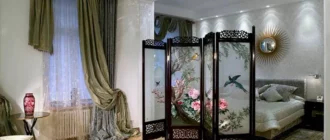
Ethnic style in the interior, also called folklore or ethnicity, is a design direction, which is characterized by the stylization of housing in the spirit of the traditions of a particular people in the pre-industrial era. There are a lot of regions with interesting and unique features of life, so the ethnic style in the interior is unusually diverse. This is a good way to give the atmosphere personality without sacrificing comfort and environmental friendliness.
The ethnic style in the interior in the general sense includes many well-known trends, for example, Scandi or Provence, but due to their popularity they are often considered separately. Ethnicity usually means something more rare and exotic – Egyptian, Moroccan, Mexican, Indian, Japanese or Chinese styles. It is important to remember that elements are borrowed not from modern culture, but from the ancient heritage of these countries.



The main characteristics and features of the ethnic style in the interior
The ethnic style in the interior is close to the eco-style, as it recreates the features of those eras when modern materials were not yet known. It is also far from luxury – simple plaster and textiles, ceramics and wood are used, forging without complex patterns. As a rule, the traditions of everyday life that go back thousands of years are read by a person at a subconscious level and are associated with comfort and safety. Once in such an environment, you immediately feel at home.

The following features of ethnic style help to achieve this effect in the interior:
- Decoration Materials. The floor, walls and ceiling often serve as a backdrop for bright accessories and do not require detailed elaboration. The walls can be covered with an uneven layer of plaster and painted in a light color. Wooden beams look appropriate on the ceiling, the floor is covered with terracotta tiles, boards or mats.
- Color spectrum. Each region has its own shades, so the color palette is highly dependent on the chosen direction. For example, the Egyptian style is dominated by yellow, sand and brown, while the Chinese style is dominated by red and gold. In most cases, natural warm colors are used.
- Furniture. For this direction, original and expressive furniture is needed, including those similar to those made by hand. Wicker chairs or sofas upholstered in coarse natural fabrics are great. In some Eastern cultures, low tables and bedside tables are common.
- Lighting. Instead of LED strips and crystal chandeliers, you should use simple glass lanterns, table lamps with a terracotta or Ming-styled base, fabric-covered lampshades. A great option is live fire from candles and a fireplace.
- Textile. Ethnic themes are often found among mass-produced fabrics, so textiles are one of the easiest ways to give a room an exotic touch. Often used are traditional patterned carpets, handmade bedspreads, simple cut curtains, including roller ones.
- Ornaments. For decoration, patterns characteristic of a particular culture are almost always used. Most often, floor coverings, fabric products or ceramic tiles are decorated with authentic patterns. Ornament can be applied to the wall using a stencil or hang pictures with appropriate motifs.

The main attention in the design of the premises is given to accessories. Masks, fans, animal skins, crockery and caskets with regional painting – often these are the things that inspire hosts to create a suitable environment for them. In the Chinese style, images of dragons and porcelain vases are welcome, in the Japanese style, samurai swords, drawings with hieroglyphs, and so on. Accessories usually serve as accents and shape the mood of the design.



The history of ethnic style in the interior
The idea of decorating the house with unusual items and souvenirs from other countries is inextricably linked with navigation and travel, especially mass travel. It is believed that the history of ethnic style in Europe begins with the first Crusades, when many people visited the Middle East. Also, the direction flourished in the era of the great geographical discoveries. During the colonial period, residents of European homes everywhere used things from India, Sri Lanka and China.



In the second half of the 20th century, tourism became available to an increasing number of people who were inspired by the culture and traditions of exotic countries. Many sought to bring some of this outlandish atmosphere into their home, and at the same time use the souvenirs they brought with them. In the 21st century, this trend has intensified even more. Thanks to numerous TV programs and travel blogs, you can get acquainted with the interesting customs of the far corners of the planet without leaving your country. Ethnicity is unusually diverse, so that the rooms are different from each other. Also this design is eco-friendly and relatively easy to implement.



































